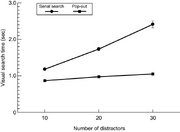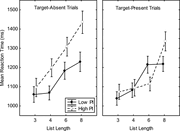71. The modal model suggested that information processing is sequential (sensory storage to attention to perception to STM to LTM), like in visual search (where the time to find a target like F increases as the search array of Es, Ls, and Ts gets larger) or serial, exhaustive memory search (e.g., Sternberg’s Serial Probe Recognition Task). However, there is also evidence of parallel processing—pop-out effects in visual search for example, where targets are located equally quickly, irrespective of array set size. The parallel distributed processing (PDP, or connectionism) neural-network models (many using Hebb l

Visual search results from Maekawa et al. (2018)
earning algorithms from Thing #69) that became popular following Rumelhart & McClelland’s (1986) influential books, highlight the fact that multiple cognitive processes can, and often do, work simultaneously.
Townsend, J. T. (1990). Serial vs. parallel processing: Sometimes they look like Tweedledum and Tweedledee but they can (and should) be distinguished. Psychological Science, 1(1), 46-54. https://pdfs.semanticscholar.org/c8e3/0adb482df3c1c073e6ce35342fc0c82dce74.pdf

Serial probe recognition takes 30 to 50 msec longer with each additional to-be-remembered item (from Cowan and Saults, 2013). PI = proactive interference
McClelland, J. L., Rumelhart, D. E., & PDP Research Group. (1987). Parallel distributed processing (Vol. 2). Cambridge, MA:: MIT press.http://web.stanford.edu/~jlmcc/papers/PDP/Volume%201/Chap1_Part1_PDP86.pdf